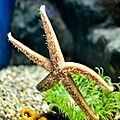Greater Cleveland Aquarium facts for kids
 |
|

Greater Cleveland Aquarium exterior
|
|
| Date opened | January 21, 2012 |
|---|---|
| Location | 2000 Sycamore Street Cleveland, Ohio 44113 U.S. |
| Coordinates | 41°29′47″N 81°42′14″W / 41.4963°N 81.7039°W |
The Greater Cleveland Aquarium is a cool place to visit in Cleveland, Ohio. It's located inside the old FirstEnergy Powerhouse building, right by the Cuyahoga River. This aquarium opened in January 2012. It has about 70,000 square feet (6,500 square meters) of space for its exhibits. You can see 55 different exhibits with fish from both local Ohio waters and faraway places. It's the only independent aquarium in Ohio, and it brought a public aquarium back to Cleveland after 26 years!
Contents
A Look Back: Cleveland's First Aquarium
Cleveland actually had an aquarium before this one! It opened on February 6, 1954, in Gordon Park, Cleveland. This first aquarium was a team effort by the Cleveland Aquarium Society, the City of Cleveland, and the Cleveland Museum of Natural History. It was set up in a building that used to be a bathhouse. Before becoming an aquarium, it was a small museum showing local plants, animals, and fish from Lake Erie.
Growing and Moving On
In the early 1950s, the Cleveland Museum of Natural History moved to a new building. They brought their fish collection to the new Cleveland Aquarium. Volunteers from the Cleveland Aquarium Society helped fix up the old building for about $25,000.
The aquarium had 50 exhibits with both freshwater and ocean animals. You could see amazing creatures like sharks, sawfish, seahorses, eels, squid, octopus, and coral. In 1966, they even got some rare Australian lungfish. Later, in 1970, a group of red-bellied piranhas joined the collection. The aquarium was very popular and often had more visitors than it could handle! In 1967, a generous gift helped build a new section, making the aquarium three times bigger.
However, the old aquarium faced some money problems. In June 1985, the building had structural issues, so it had to close to the public. The fish and exhibits were then moved to the Cleveland Metroparks Zoo in April 1986, where some of them still are today.
The New Aquarium Opens
The idea for a new aquarium started in 2009. It was first planned to be much bigger and more expensive. But people had been thinking about a new aquarium ever since the old one closed in 1985. A local developer named Jeffrey P. Jacobs was a big part of making it happen. He wanted the aquarium to be in the Powerhouse building, which he owned.
Many groups worked together to fund the new aquarium. The City of Cleveland, Marinescape, and Jacobs Entertainment, Inc. all invested money. FirstEnergy and AMPCO also helped out.
A special opening ceremony was held on January 19, 2012. The Greater Cleveland Aquarium then opened its doors to everyone on January 21. In 2014, Jacobs Entertainment, Inc. bought the aquarium completely.
What You Can See and Do
The Greater Cleveland Aquarium cost about $33 million to build and set up all the exhibits.
In 2018, the aquarium started making big improvements to its public areas. They used many recycled materials and upgraded the systems that keep the animals healthy. They also added more than a dozen new species! In 2022, the aquarium welcomed its two millionth visitor. They also celebrated the rare birth of weedy sea dragons, which is something only a few aquariums in the world have seen.
Today, when you visit the Greater Cleveland Aquarium, you can explore many cool areas. These include:
- Ohio Lakes & Rivers
- Asia & Indonesia
- Tropical Forest
- Powerhouse History
- Industry & Habitat
- Coastal Boardwalk
- Tropical Reef
- Shark Gallery
The aquarium also offers daily activities. You can ask questions to SCUBA divers in the shark tank or watch aquarists feed the animals. There are also discovery carts, chances to meet animals, two touchpools, and a 175-foot underwater tunnel called a seatube. All these are included with your general admission ticket!
Special Events and Experiences
The Greater Cleveland Aquarium has a calendar full of fun special events. These include Fin Fest and Scuba Claus. Since 2020, they've also had Pumpkins and Piranhas instead of Hauntaquarium.
Besides special events, you can enjoy daily interactive experiences. These include talks by aquarists, animal encounters, and SCUBA diver talks underwater. If you are a certified SCUBA diver, you can even dive in the Shark Gallery through their Shark Dive CLE program. (Note: Shark Dive CLE is currently paused as of August 2025).
Helping Our Planet: Conservation Efforts
In 2012, the aquarium's general manager, Tami Brown, started a non-profit group called the Splash Fund. This fund helps teach people about aquatic life and encourages them to protect freshwater and saltwater habitats.
The Splash Fund raises money for important projects. They regularly organize Adopt-A-Beach cleanups at Edgewater Park. They also help schools in need get access to science programs about aquatic life. The fund also works to help increase the population of spotted turtles in Northeast Ohio. The Splash Fund is part of a bigger program called Saving and Protecting Ohio Turtle Diversity (SPOTD). This program works with many partners to help boost the numbers of native spotted and Blanding's turtles, which are currently threatened.
Images for kids












